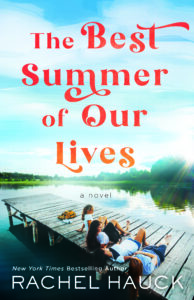by Rachel Hauck @rachelhauck
Hey everyone! Thanks for stopping by. It’s an honor to be on the ACFW blog today. Never mind the post I missed in September. But let’s not talk about it, okay?
I’ve been doing a series of storytelling tips on my Twitter account, so I thought I’d share some with you.
Tip #1: Writing who you are will get your farther than writing what you know.
The first writing advice I ever heard was, “write what you know.” So I wrote about riding to school with my brother and his friends, trapped in the back of a ’69 Barracuda with a rusty hole over the exhaust. I got an A on the piece.
But the reality is, I don’t know all that much. I think I blew my collective “knowledge” on my first trade paperback, Georgia On Her Mind. What next?
“Write what you know” is best translated, “write who you are.” I had to dig deep, figure out who I was as a writer, and tell the stories only I could tell.
Who am I? A wife, a sister and daughter, a friend, a Believer, a singer, a hybrid-southerner by way of Oklahoma and Kentucky, but mostly a Florida girl with Ohio blood. I am a former sorority girl. I’m an encourager. A reader. I could go on and on, but you get the idea.
My post-college corporate job had me on the road for seventy percent of four years. I went to Australia twice, Spain, Mexico three times as well as Venezuela, Ireland, and across the United States. Every step of the way, I was writing my story that would ultimately make up the characters in my books.
So who are you? What’s your world experience and view? How does it come out on the page? How does it influence your characters and their stories?
Writing who you are will get you farther than writing what you know. @rachelhauck #writing #writingtips #ACFWcommunity Click To TweetTip #2: Tell the story between the quotes.
If you’ve been in any workshop I’ve taught, you’ve heard me say this.
Dialog is the fuel to every story – this is another favorite saying of mine. Dialog creates the tension and reveals the characters. How do we assess any person? By watching and listening. Dialog lets the reader in on the inner workings of your character. If it doesn’t, you might need to do some more character work.
Even for authors who have a “storyteller” voice—heavy prose—resetting a scene with more dialog can increase the emotional tension. So let the characters speak.
Tip #3: Make your children innocent yet sound like “little adults.”
I know, this is a weird one, but bear with me. I’ve read two books this year with pre-teen children as key secondary characters. While the authors kept the child’s knowledge of the world at the appropriate level, the children were wise and insightful.
The children often helped the protagonist’s story arc because of their innocence, but they also forced the protagonist to get outside themselves and think of someone else.
Avoid babytalk. Avoid misspelled words. The context of the scene should give the reader an “ear” for how the child sounds.
Tip #4: Physical reactions do not take the place of emotion.
This one is tough to explain. While the reader needs to see the characters physically react to some situations, these reactions cannot take the place of emotion. A character shrugging, smiling, blinking, chewing on a thumb nail or a lip, delivers no emotion. Yes, a smile or laugh, a shrug, can add subtext to the overall emotion of a scene but show verses tell is about emotion. Show us the emotion through dialog, internal thought, and action. Edit your shrugs, blinks, bites, or smiles by asking, “How can I go a deeper?” What is the character really feeling or thinking? I even ask, “Do I need this?” Often I delete the action and move ahead with dialog. Trust the scene to deliver the emotion.
That’s all the tips for today! I hope they helped. Keep writing!
 Rachel Hauck is an award winning, New York Times bestselling author. Here newest book, The Best Summer of Our Lives, was an instant bestseller. A graduate of Ohio State University with a degree in Journalism, she lives sunny central Florida with her husband, whom she affectionately calls George.
Rachel Hauck is an award winning, New York Times bestselling author. Here newest book, The Best Summer of Our Lives, was an instant bestseller. A graduate of Ohio State University with a degree in Journalism, she lives sunny central Florida with her husband, whom she affectionately calls George.

Comments 4
I love these tips. Thank you, Rachel.
Thank you, Rachel. This one is a keeper. 🙂
Blessings,
MaryAnn
Brilliant! After all these years I finally understand “write what you know” – and it makes perfect sense now.
Thanks for stopping by!!